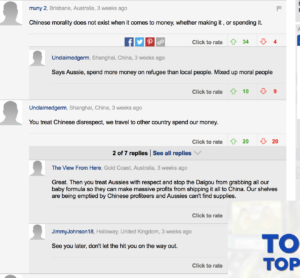
Comparative Online News Journalism Analysis
Daily Mail and Travel Weekly
Daily Mail Online: www.dailymail.co.uk
Publishing Context
The Daily Mail was established in 1896 and published in London. Today, the newspaper is headquartered in Northcliffe House, London. It is the best-selling daily newspaper after The Sun with 2.6 million readers. Geordie Greig is the editor of the Daily Mail since 2018, and its chairman is Jonathan Harmsworth-4th Viscount Rothermere. Daily Mail Online is based on The Daily Mail and General Trust.
The Daily Mail’s target audiences are “Middle England” (Daily Mail, 2018) with an average age of 58, and the lowest number of readers between the ages of 15 and 44 (Henry, 2014). More than 100 million visitors browse the website every month, among which 55% are female readers (Fearn, 2017). In addition, 53% voted for the Conservative Party in 2004 (MORI, 2005) because this newspaper holds the tone of the Conservative Party.
The chairman, Viscount Rothermere cares about circulation. In 2017, The Daily Mail was issued more than 1 million pieces. In the meantime, he also wants to provide editors with sufficient freedomto create content. Therefore, the editorial policies can be designed by the editors themselves (Dan, 2008).
Daily Mail Online: ‘Fury as unscrupulous tour operators charge Chinese tourists entry fees to visit free Gold Coast beaches and parks – sparking fears it will damage tourism’ Full reference – see Chapman (2019)
This article was published on Daily Mail Australia on 10 March 2019. This topic is popular among Chinese-Australian and also has been reported in other countries. This news that many deceived Chinese tourists paid thousands of dollars for public attractions in Australia because the travel agencies conceal the additional costs. Tourism officials and some experts worry and condemn this situation.
Fair, Accurate and Audio-visual
In this report, the journalist uses a third-person perspective to make reports. Compared to Courier Mail which points out that Chinese travel agencies deceive Chinese tourists in the headline, there just say “some tour operators” in Daily Mail.

To some extent, the headline of Courier Mail can lead to racist public opinion.It can be seen in the comments after the Daily Mail’sreport. Some readers insult all Chinese in thecomment area and fight withthe web visitors from China,causing the Daily Mail to no longer to accept comments on this article. The journalist of Daily Mail just uses ‘dodgy’ to express his dislike of these behaviours, no prejudice against any group, but objective use of words.

At the same time, the journalist uses the words of the chief in QTIC (Queensland Tourism Industry Council) and the Minister of State Tourism making the article more reliable. The information is similar in quality to the content in Courier Mail. And there is also a reader who commented that it did happen on the Gold Coast. However, the only tour operator interviewed did not leave a real name or any other information that could verify that his/her words were true. Also, experts warned that this situation had not been specified.
In the article, there are three pictures of the Gold Coast and Chinese tourists, but none of them has relevance with the content of the report. These pictures are more like an introduction of the views, rather than showing the audience what happened in this place.
Interactivity, Multimediality and User Engagement
In the article of Daily Mail, it only includes text and pictures without any multimedia techniques. However, it is a scannable work with brief contents. The journalist lists four key pieces of information at the beginning of the article, which can engage the audience to read the content, or even can jump to the comment after reading the key information.
As Martin (2006) puts it, interactivity includes dialogue with the audience, selectivity of articles, audience’ registration and the immersion created by the article. The Daily Mail Online makes a comment available first to make the visitors immerse in this situation and claim their own opinions until someone starts making cyber violence over there. Before closing the comment function, there are more than 40 visitors to give their own words.
Online Delivery
This article supports sharing with Facebook, Twitter and other social media, which is an interactive technology to engage the audience to share the topic to their social media platforms and attract more visitors to read this report and participate in this topic.
All the articles of the journalist can be read when the visitors click on the name of the journalist online. However, there is not a contact of the writer, readers cannot communicate with him directly.
Technical Delivery
There are two links in the report, but none of them can be opened in new tabs. It will make the story hard to navigate. Meanwhile, the first link regarding the Gold Coast jumps to many other irrelevant articles which have this keyword but are of no value to the story.
The second link is for the Courier Mail, but it doesn’t add any value to the audience, as the linked articles can only be read after the readers have subscribed to the newspaper.
Inserting an ad into the article will separate the whole story and will be detrimental to the legibility of the text, because the irrelevant information can divert audience’ attention away from the story itself (Simon, 1971).
Travel Weekly: travelweekly.com.au
Publishing Context
Travelweekly. com. au is the digital offering of Travel Weekly. It is a national newspaper for tourism established in October 1958. Travel Weekly is a recognized authority that provides information about tourism in education and innovation. It is also a commercial platform to connect audiences and advertisers.
Travel Weekly is Australia’s best-read travel magazine, which can email travel breaking news to over 16,000 audiences a day.
Its target audience is travel professionals and those who want to learn about travel-related authoritative information. (Travelweekly.com.au). There is no detailed information about demographics, no staff members to respond to this question, and no results can be found through extensive web searches.
Travelweekly.com.au: ‘Tour operators misleading Chinese tourists with fake University of Sydney claim’ Full reference – see Travelweekly.com.au (2019)
This report talks about Chinese tourists who believe that USYD’s Quadrangle is the building of the movie “Harry Potter” due to the false claims of some travel agencies.
Journalistic Writing and Content Production
The source of this article is from SBS (Special Broadcasting Service) News. With a hybrid fund, it is an Australian public broadcasting network (including TV, online and radio) and is one of Australia’s five major networks.
However, Travel Weekly’s article is more like the worst copy of SBS’s because it does not strike a balance between original and rewrites with many authority problems. Firstly, the author sums up the issue by the causal relationship of the counterfeit claim and the tourism boom, but there is no evidence to confirm this causal relationship, and even SBS has not reached this conclusion. Secondly, there are two pictures inserted into the story, but both of them are screenshots with language in Chinese and the caption without translation under the picture to help the audience understand the content of these images. Finally, there are no details about the tour operator and tour guide to verify the authenticity of the information.
Interactivity and Poor User Engagement
There is less interactivity. The audiences cannot understand the relationship between the article and the pictures if they do not understand Chinese. Compared to the source of SBS (in which video about the USYD campus is inserted), this story has no multimedia technique, although there is a comment, only one visitor leaves it.
Online Delivery
This report and its comments can be shared with Facebook, LinkedIn, and other social media. However, the early reporters work together by the convergent approach (Bradshaw, 2018), but there is no specific writer’s name. As each reporter is only responsible for their own content, the quality of the content cannot be controlled if there is any writer with a lack of responsibility.
Technical Delivery
The link in this article is useful because it can jump to the original source of SBS. In this way, readers can understand the whole story more clearly. There are keywords under the news, which can help SEO more effectively, but the downside is that there are too many ad pop-ups, so they must optimize the webpage to improve its usability. Follow that, there are too many latest news beneath one article through the whole website-they must enhance the functionality of these webpages.
References
Bradshaw, P. (2018). Histories, Futures and The Changing Business and Technologies of Online Journalism. Online Journalism Handbook: Skills to survive and thrive in the digital age, pp. 5–50.
Bull, A. (2016). Creating a Publishing Platform. In Multimedia Journalism, pp. 65–87. Routledge. ISBN: 978-1138-79284-5
Correction: Daily Mail website. (5 January 2013). The Economist. Retrieved from. https://www.economist.com/business/2013/01/05/correction-daily-mail-website
Dan, S. (2008). Paul Dacre Can Set Daily Mail Agenda, Says Viscount Rothermere. The Times. Retrieved from https://www.thetimes.co.uk/article/paul-dacre-can-set-daily-mail-agenda-says-viscount-rothermere-lh5n5hb3jc2
Fearn, H. (2017). The Daily Mail Has A Mainly Female Readership-So Why Do Women Enjoy Those Who Won Legs-it Headlines? The Independent. Retrieved from https://www.independent.co.uk/voices/daily-mail-brexit-legs-it-theresa-may-nicola-sturgeon-female-readershop-women-feminism-a7654326.html
Henry, T. (2014). How old are you again? UK newspaper age demographics in 4 charts. The Media Briefing.
MORI survey of newspaper readers. (2005). Retrieved 20 March 2019 from. https://archive.is/20071213203908/http://www.ipsos-mori.com/polls/2004/voting-by-readership.shtml
Martin, F. (2002). Beyond Public Service Broadcasting? ABC Online & The User/Citizen. Southern Review, vol. 35, no.1, pp. 42-62.
Simon, H. A. (1971). Designing Organizations for an Information-Rich World. Communication, and the Public Interest, Baltimore,pp. 40–41.



Be the first to comment